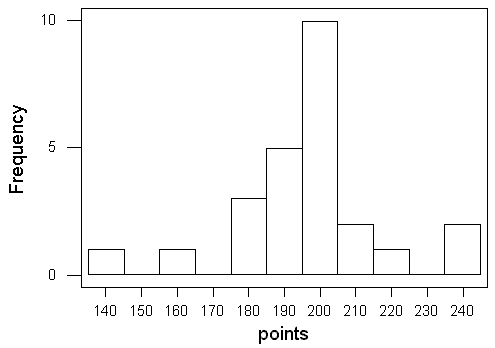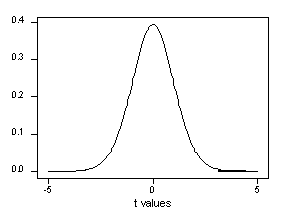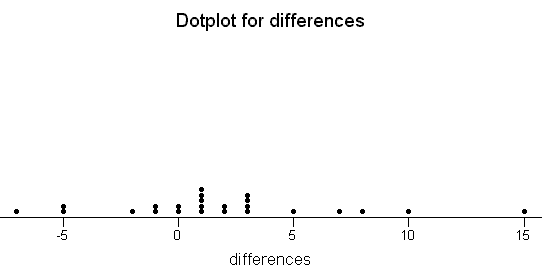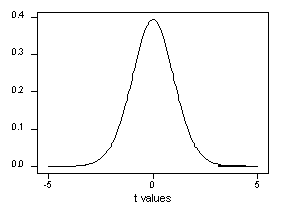Workshop Statistics: Discovery with Data, Second
Edition
Topic 22: Tests of Significance II: Means
Activity 22-1: Basketball Scoring
(a) m = 183.2 (null hypothesis)
(b) m > 183.2 (alternative hypothesis)
(c)
The distribution looks pretty symmetric, though has some outliers on
both ends. Many of the observations fall above 183.2 points. This indicates
some
evidence of an increase in the points per game scored after the rule
change.
(d) sample mean,  =
195.88; sample standard deviation,
s=20.27
=
195.88; sample standard deviation,
s=20.27
(e) yes
(f) yes, sampling variability
Activity 22-2: Basketball Scoring (cont.)
(a) Ho: m = 183.2 ; Ha:
m
> 183.2
(b) t=3.12
(c)
Iíve shaded above 3.13. Note, this shaded region is not very big, so
I expect the probability I calculate to be rather small.
(d) The area to the right of our test statistic is between .001 and
.005.
(e) The p-value tells us that there is between a .1% and .5% chance
that weíd get a sample mean this big (>195.88) if there was no improvement
in scoring
after the rule changes.
(f) We would reject the null hypothesis at a levels of .10, .05, .01,
and .005. Even though we donít know the p-value exactly, we know itís smaller
than these
values.
Note: The answers to (g) and (h) below are the
answers to (h) and (i), respectively, in the Calculator version.
(g) First, we wouldíve needed a simple random sample of games
from this season. We didnít have that, but it might be reasonable to assume
that games
midseason are fairly representative. Second, since our sample size
is less than 30, we would need to know the population of points per game
follow a normal
distribution. We canít verify that, but the sample looks reasonably
normal.
(h) The sample data does provide evidence that the mean points
per game in the 1999-2000 season is higher than in the previous season.
Still, we must be very cautious in this conclusion since the technical
conditions are not exactly met (e.g. maybe scores tend to be higher in
December).
Activity 22-3: Sleeping Times (cont.)
Results will vary depending on class results, but the set up is:
(a) Let m=average sleep time of all students
at the school
H0: m=7 (get 7 hours on average)
Ha: m<7 (is there evidence
of less than 7 hrs)
(b) technical conditions
Do you think students from your class are representative of students
from the whole school? Would be questionable if it is a morning class.
If sample size of class is greater than 30, the normality condition
will be considered satisfied.
(c) Sample 1 supplies stronger evidence that m
< 7 because it has a smaller standard deviation.
(d) Sample 3 supplies stronger evidence that m
< 7 because it has a larger sample size.
(e)
|
Sample number
|
Sample size
|
Sample mean
|
Sample std. dev.
|
p-value
|
|
1
|
10
|
6.6
|
.825
|
.080
|
|
2
|
10
|
6.6
|
1.597
|
.224
|
|
3
|
30
|
6.6
|
.825
|
.006
|
|
4
|
30
|
6.6
|
1.597
|
.090
|
(f) sample 3
(g) Our conjectures in (c) and (d) are correct.
Activity 22-4: Marriage Ages (cont.)
(a) The differences, in order, are: 3, -7, 1, 0, 5, 3, 15, 7, 1, 10, 0,
-5, 1, 1, 3, -2, -1, -5, 2, 2, 3, 8, 1, -1
(b)
(c)  =
1.875; s = 4.812; n = 24
=
1.875; s = 4.812; n = 24
(d) The parameter of interest is m=the
mean difference in ages at the time of a Cumberland County, PA couple's
marriage (husband - wife).
Ho: m
= 0 (no age difference on average)
Ha: m
> 0 (husbands tend to be older on average)

n is not greater than 30 but the sample of differences looks
reasonably normal. We are considering these couples a simple random sample
of couples in Cumberland County, PA, in 1993.
t = 1.90
23 degrees of freedom
The area to the right of
the t-statistic is between .025 and .05, which suggests moderately strong
evidence against Ho.
The p-value is less than .05. Therefore we reject Ho and
conclude that there is significant evidence that husbands tend to be older
on average in this population.
(e) (0.191, 3.558); This interval does not include zero.
Again, must consider the technical conditions.
(f) There is enough evidence to reject the null hypothesis that
m
= 0, as long as the sample was random and the population differences comes
from a normal distribution. If so, have statistically significant
evidence that men are older. The confidence interval indicates that this
mean age difference is between .19 years and 3.6 years.



